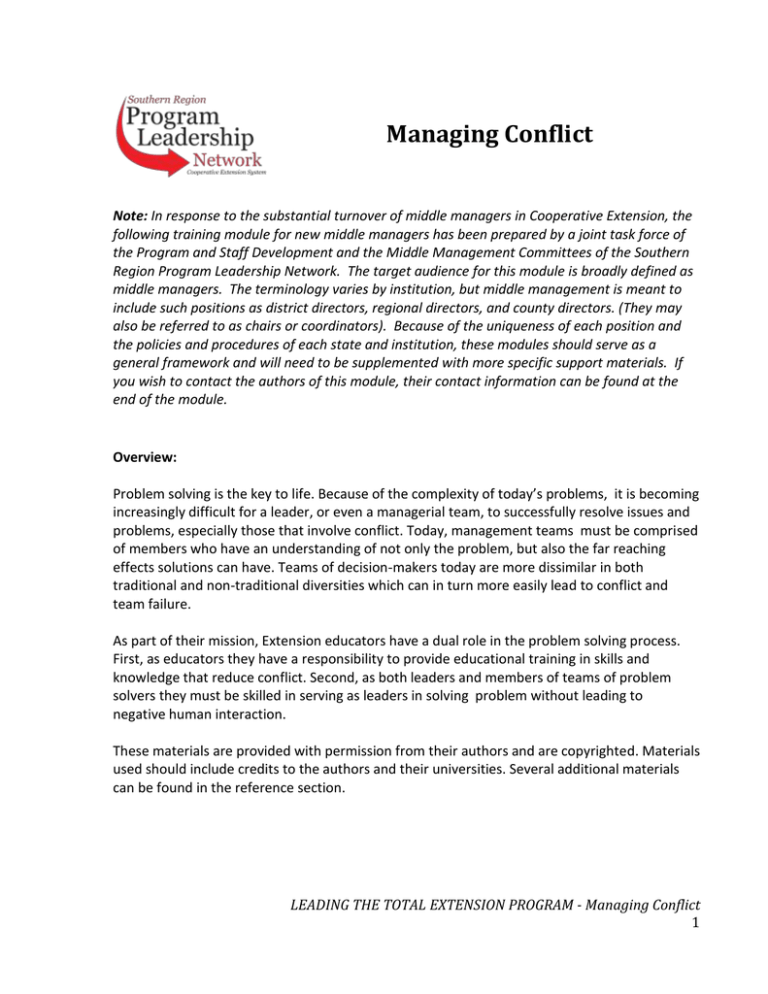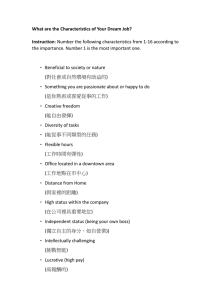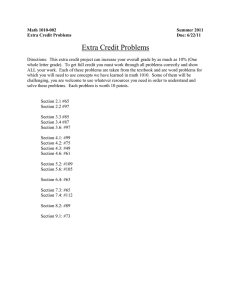Managing Conflict
advertisement

Managing Conflict Note: In response to the substantial turnover of middle managers in Cooperative Extension, the following training module for new middle managers has been prepared by a joint task force of the Program and Staff Development and the Middle Management Committees of the Southern Region Program Leadership Network. The target audience for this module is broadly defined as middle managers. The terminology varies by institution, but middle management is meant to include such positions as district directors, regional directors, and county directors. (They may also be referred to as chairs or coordinators). Because of the uniqueness of each position and the policies and procedures of each state and institution, these modules should serve as a general framework and will need to be supplemented with more specific support materials. If you wish to contact the authors of this module, their contact information can be found at the end of the module. Overview: Problem solving is the key to life. Because of the complexity of today’s problems, it is becoming increasingly difficult for a leader, or even a managerial team, to successfully resolve issues and problems, especially those that involve conflict. Today, management teams must be comprised of members who have an understanding of not only the problem, but also the far reaching effects solutions can have. Teams of decision-makers today are more dissimilar in both traditional and non-traditional diversities which can in turn more easily lead to conflict and team failure. As part of their mission, Extension educators have a dual role in the problem solving process. First, as educators they have a responsibility to provide educational training in skills and knowledge that reduce conflict. Second, as both leaders and members of teams of problem solvers they must be skilled in serving as leaders in solving problem without leading to negative human interaction. These materials are provided with permission from their authors and are copyrighted. Materials used should include credits to the authors and their universities. Several additional materials can be found in the reference section. LEADING THE TOTAL EXTENSION PROGRAM - Managing Conflict 1 Objectives: Recognize the benefits of successfully working with challenging people and situations Identify the characteristics that lead to conflict Understand one’s own methods of interaction that can lead to conflict Identify methods that successfully manage diversities Identify strategies that can reduce conflict Advance Preparation: Read through materials and make selections based on level and type of conflict Read suggested references Obtain supplies Print handouts and copies of slide shows Materials Needed: Computer/projector/screen Flipchart/markers Sticky note paper Publication 1. Managing Challenging Situations and People Contact: Renee Daughtry, Ph.D. and Sue Williams, PhD, Oklahoma State University (This section is part of a larger Leadership training module found at (http://fcs.okstate.edu/leadership/Developing%20Effective%20Leaders%20Teaching%20 Modules.htm) Includes: participant’s packet, Instructor’s guide and power point Handouts: Developing Effective Leaders: Managing Challenging Situations and People—Participant’s Packet (includes activities) Guides: Developing Effective Leaders: Managing Challenging Situations and People—Instructor’s Guide Slide Shows: Developing Effective Leaders: Managing Challenging Situations and People Time Needed: 3 hours LEADING THE TOTAL EXTENSION PROGRAM - Managing Conflict 2 BACKGROUND This module provides information and activities related to conflict management. It includes a participants packet, instructor’s guide and powerpoint. The major concepts covered are all tied to developing more effective leaders by teaching them to manage challenging situations as well as challenging people. Additional references used to create this training packet are listed in the reference section for easy access. INTEREST APPROACH This module provides information dealing with constructive solutions when faced with disagreement. Not only does it identify personality types and traits that can cause conflict but it provides solutions and case studies for opportunities to discuss and solve issues that lead to effective human interaction. LESSON Challenging situations and people introduction of terms and background Managing conflict creatively General strategies for handling challenging people and situations APPLICATION Activity: “The Golden Watch” (10 minutes) o Allow the participants five minutes to read the Gold Watch Handout o Ask them to rank the six characters in order of most objectionable to least o Follow with a discussion Activity: “Your Conflict Management Style” (15 minutes) o Complete and grade the self-assessment instrument “Your Conflict Management Style o Results will be used in the section on conflict Resolution Teams Activity: “Are you listening?” (10 minutes) o Do this activity with several people to determine each ones listening strength Activity: “Case studies” (20 minutes) o Divide the groups into clusters of 3-5 people and have each team select a leader o Assign a case study LEADING THE TOTAL EXTENSION PROGRAM - Managing Conflict 3 o They should have a discussion on conflict resolution they should use the strategies they learned in this section to discuss the case study assigned. REFERENCES Bramson, R.M. (1988). Coping with difficult people. New York: Dell. Clike, K. & Goldsmith, J. (2000). Conflict as opportunity. Leader to Leader, 15 (11). Fisher, R. and Ury, W. (1992). Getting to yes: Negotiating agreement without giving in. (2nd ed.) New York: Hourghton Mifflin. Harvey, J.B. (1988). The Abilene paradox: The management of agreement. Organizational Dynamics, 17(1) 17-43. Maister, D.Hh. (2000). True professionalism. New York: The Free Press Parrott, L. (1996). High-maintenance relationships. Wheaton, IL: Tyndale House Publishers, Inc. Pike, B., & Arch, D. (1997). Dealing with difficult participants: 127 practical strategies for minimizing resistance and maximizing results in your presentations. San Francisco, CA: Jossey-Bass Pfeiffer. Risher, R. and Ury, W. (1988). Getting to yes: Negotiating agreement without giving in. New York: Penguin Books. Sashkin, M. (1995). Conflict style inventory: Trainer guide. Amherst, MA: Human Resource Development Press, Inc. Zehring, J.W. (1989). Working smart: A handbook for new managers. Exchange, December, p. 31. Zemke, R. (1987). Working with jerks. Training, May, p. 27-38. Other recommened Conflict Training Modules: Turning Lemons into Lemonade: Public Conflict Resolution found at url: http://srdc.msstate.edu/trainings/lemons/221.html Includes: Instructors guide, participant’s guide, overheads and Power point overheads. Authors: Ronald J. Hustedde and Jarad J. Kapsa,, University of Kentuck, and Steve Smutko, North Carolina State University LEADING THE TOTAL EXTENSION PROGRAM - Managing Conflict 4 Developed by: Cheri Winton Brodeur, Ph.D. Coordinator, Program Development and Evaluation Center (PDEC) Institute of Food and Agricultural Sciences University of Florida 2087 McCarty Hall 352-392-0386 352-392-9633 fax http://pdec.ifas.ufl.edu http://solutionsforyourlife.com Rachel Welborn Program Manager, Southern Rural Development Center 662.325.5885 (phone) 662.325.8915 (fax) P.O. Box 9656 Mississippi State, MS 39762 Tony Tyson, P.E. Director of Extension Co. Operations 111 Conner Hall Athens, GA 30602 706-542-1060(office) 706-614-6323(mobile) ttyson@uga.edu LEADING THE TOTAL EXTENSION PROGRAM - Managing Conflict 5

